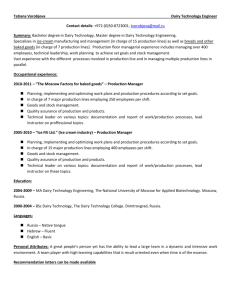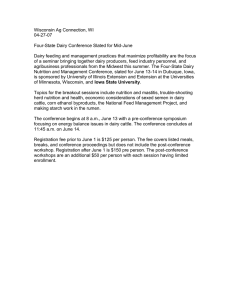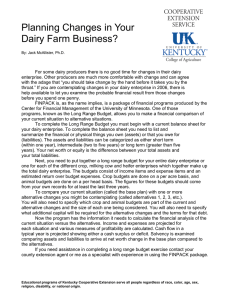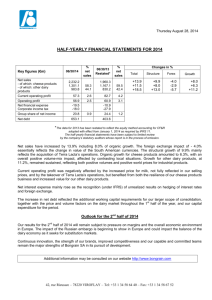Document 11646517
advertisement
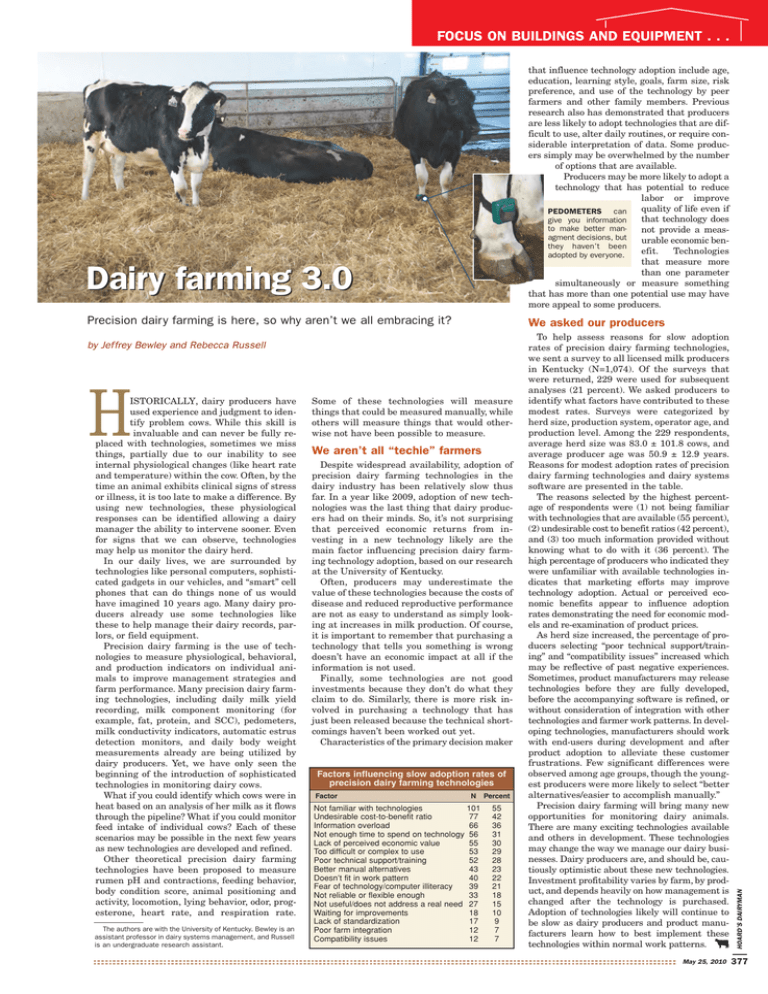
FOCUS ON BUILDINGS AND EQUIPMENT . . . that influence technology adoption include age, education, learning style, goals, farm size, risk preference, and use of the technology by peer farmers and other family members. Previous research also has demonstrated that producers are less likely to adopt technologies that are difficult to use, alter daily routines, or require considerable interpretation of data. Some producers simply may be overwhelmed by the number of options that are available. Producers may be more likely to adopt a technology that has potential to reduce labor or improve quality of life even if PEDOMETERS can that technology does give you information to make better mannot provide a measagment decisions, but urable economic benthey haven’t been efit. Technologies adopted by everyone. that measure more than one parameter simultaneously or measure something that has more than one potential use may have more appeal to some producers. Dairy farming 3.0 Precision dairy farming is here, so why aren’t we all embracing it? by Jeffrey Bewley and Rebecca Russell H ISTORICALLY, dairy producers have used experience and judgment to identify problem cows. While this skill is invaluable and can never be fully replaced with technologies, sometimes we miss things, partially due to our inability to see internal physiological changes (like heart rate and temperature) within the cow. Often, by the time an animal exhibits clinical signs of stress or illness, it is too late to make a difference. By using new technologies, these physiological responses can be identified allowing a dairy manager the ability to intervene sooner. Even for signs that we can observe, technologies may help us monitor the dairy herd. In our daily lives, we are surrounded by technologies like personal computers, sophisticated gadgets in our vehicles, and “smart” cell phones that can do things none of us would have imagined 10 years ago. Many dairy producers already use some technologies like these to help manage their dairy records, parlors, or field equipment. Precision dairy farming is the use of technologies to measure physiological, behavioral, and production indicators on individual animals to improve management strategies and farm performance. Many precision dairy farming technologies, including daily milk yield recording, milk component monitoring (for example, fat, protein, and SCC), pedometers, milk conductivity indicators, automatic estrus detection monitors, and daily body weight measurements already are being utilized by dairy producers. Yet, we have only seen the beginning of the introduction of sophisticated technologies in monitoring dairy cows. What if you could identify which cows were in heat based on an analysis of her milk as it flows through the pipeline? What if you could monitor feed intake of individual cows? Each of these scenarios may be possible in the next few years as new technologies are developed and refined. Other theoretical precision dairy farming technologies have been proposed to measure rumen pH and contractions, feeding behavior, body condition score, animal positioning and activity, locomotion, lying behavior, odor, progesterone, heart rate, and respiration rate. The authors are with the University of Kentucky. Bewley is an assistant professor in dairy systems management, and Russell is an undergraduate research assistant. Some of these technologies will measure things that could be measured manually, while others will measure things that would otherwise not have been possible to measure. We aren’t all “techie” farmers Despite widespread availability, adoption of precision dairy farming technologies in the dairy industry has been relatively slow thus far. In a year like 2009, adoption of new technologies was the last thing that dairy producers had on their minds. So, it’s not surprising that perceived economic returns from investing in a new technology likely are the main factor influencing precision dairy farming technology adoption, based on our research at the University of Kentucky. Often, producers may underestimate the value of these technologies because the costs of disease and reduced reproductive performance are not as easy to understand as simply looking at increases in milk production. Of course, it is important to remember that purchasing a technology that tells you something is wrong doesn’t have an economic impact at all if the information is not used. Finally, some technologies are not good investments because they don’t do what they claim to do. Similarly, there is more risk involved in purchasing a technology that has just been released because the technical shortcomings haven’t been worked out yet. Characteristics of the primary decision maker Factors influencing slow adoption rates of precision dairy farming technologies Factor N Not familiar with technologies 101 Undesirable cost-to-benefit ratio 77 Information overload 66 Not enough time to spend on technology 56 Lack of perceived economic value 55 Too difficult or complex to use 53 Poor technical support/training 52 Better manual alternatives 43 Doesn’t fit in work pattern 40 Fear of technology/computer illiteracy 39 33 Not reliable or flexible enough Not useful/does not address a real need 27 Waiting for improvements 18 Lack of standardization 17 Poor farm integration 12 Compatibility issues 12 Percent 55 42 36 31 30 29 28 23 22 21 18 15 10 9 7 7 To help assess reasons for slow adoption rates of precision dairy farming technologies, we sent a survey to all licensed milk producers in Kentucky (N=1,074). Of the surveys that were returned, 229 were used for subsequent analyses (21 percent). We asked producers to identify what factors have contributed to these modest rates. Surveys were categorized by herd size, production system, operator age, and production level. Among the 229 respondents, average herd size was 83.0 ± 101.8 cows, and average producer age was 50.9 ± 12.9 years. Reasons for modest adoption rates of precision dairy farming technologies and dairy systems software are presented in the table. The reasons selected by the highest percentage of respondents were (1) not being familiar with technologies that are available (55 percent), (2) undesirable cost to benefit ratios (42 percent), and (3) too much information provided without knowing what to do with it (36 percent). The high percentage of producers who indicated they were unfamiliar with available technologies indicates that marketing efforts may improve technology adoption. Actual or perceived economic benefits appear to influence adoption rates demonstrating the need for economic models and re-examination of product prices. As herd size increased, the percentage of producers selecting “poor technical support/training” and “compatibility issues” increased which may be reflective of past negative experiences. Sometimes, product manufacturers may release technologies before they are fully developed, before the accompanying software is refined, or without consideration of integration with other technologies and farmer work patterns. In developing technologies, manufacturers should work with end-users during development and after product adoption to alleviate these customer frustrations. Few significant differences were observed among age groups, though the youngest producers were more likely to select “better alternatives/easier to accomplish manually.” Precision dairy farming will bring many new opportunities for monitoring dairy animals. There are many exciting technologies available and others in development. These technologies may change the way we manage our dairy businesses. Dairy producers are, and should be, cautiously optimistic about these new technologies. Investment profitability varies by farm, by product, and depends heavily on how management is changed after the technology is purchased. Adoption of technologies likely will continue to be slow as dairy producers and product manufacturers learn how to best implement these technologies within normal work patterns. May 25, 2010 HOARD’S DAIRYMAN We asked our producers 377

